The studio lighting landscape is experiencing a revolutionary transformation, forcing a hard look at the true PoE studio lighting cost versus traditional setups.
While legacy broadcast facilities struggle with lengthy permitting processes and expensive electrical work, innovative organizations are embracing a game-changing solution that delivers a dramatically faster ROI.
This transformation starts with the elegance of a single cable. Traditional studio builds demand complex, separate runs for power, data, and control—each creating delays and coordination headaches. PoE brilliantly consolidates everything into one Cat6 connection, delivering an architectural breakthrough that unlocks previously impossible opportunities.
Why Studios Are Embracing Lighting Innovation in 2025
This transformation starts with the elegance of a single cable. Traditional studio builds demand complex separate runs for power, data, and control—each creating delays, costs, and coordination headaches. PoE brilliantly consolidates everything into one Cat6 connection, delivering an architectural breakthrough that unlocks previously impossible opportunities.
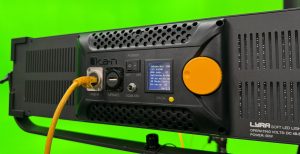
Autodesk‘s recent studio transformation exemplifies this innovation. Their engineering teams needed broadcast-quality production capabilities across multiple global offices but faced a common corporate challenge: leased spaces where permanent electrical modifications would breach building agreements. Traditional approaches would have meant navigating months of permit applications, coordinating with building management, and potentially relocating facilities entirely. Instead, they deployed Ikan’s LBX8-POE lighting systems and achieved operational status within days—no permits required, no lease violations, no frustrated facilities teams.
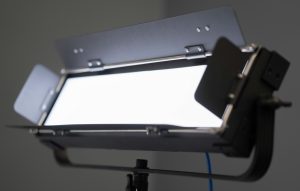
The shift toward IP-based production delivers benefits far beyond convenience. Studios operating traditional tungsten and HMI fixtures routinely consume 45 kilowatts per session. Home Depot’s Atlanta facility discovered their lighting drew so much power it masked a 50-year-old HVAC failure—the tungsten fixtures had been providing all the heating their studio needed. After embracing LED technology, power consumption plummeted by 95%, revealing the dormant heating system and dramatically slashing operational costs.
Cable management presents another compelling catalyst for change. Traditional DMX networks sprawl through studios like technological weeds, demanding specialized knowledge to troubleshoot and maintain. When Gwinnett County Public Schools planned broadcast studios across 23 locations, fire marshals explicitly prohibited floor-based power cables as safety hazards. PoE emerged as the brilliant solution that satisfied both safety requirements and educational objectives.
What Is PoE Lighting for Studios?
Power over Ethernet represents a fundamental reimagining of electrical distribution that empowers studios like never before. The IEEE 802.3bt standard, commonly called PoE++ or Ultra PoE, delivers up to 90 watts through standard network cabling—providing ample power for professional studio fixtures while maintaining classification as low-voltage infrastructure. This classification elegantly sidesteps most permitting requirements that plague traditional electrical work.
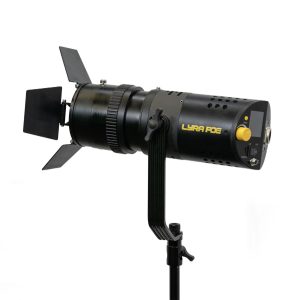
Studio-grade PoE fixtures seamlessly combine power delivery with sophisticated control protocols. Ikan’s Lyra PoE series incorporates ArtNet and sACN support directly into each fixture, enabling precise control through standard network infrastructure. A single Cat6 cable carries power, DMX-over-IP commands, and diagnostic data simultaneously—a true convergence of simplicity and capability. 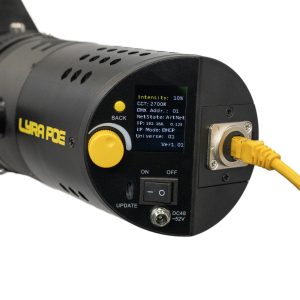
The technical specifications confidently rival traditional alternatives. Modern PoE soft panels achieve impressive 97 CRI ratings with consistent output across color temperatures from 2700K to 6500K. Beam angles of 110 degrees from soft sources provide the essential wraparound illumination for interview setups, while Fresnel variants like the LBF60Z-POE offer versatile 30 to 60-degree zoom ranges for precise key lighting applications.
Cost Breakdown: PoE vs Traditional
Hardware and Infrastructure
The economic advantages begin at installation. Traditional studio lighting demands substantial industrial electrical infrastructure: 20-amp circuits at minimum, often requiring 208V three-phase power for larger installations. Each circuit needs dedicated breakers, junction boxes, and safety disconnects. A modest 10-light installation typically requires $20,000 in electrical infrastructure alone—before purchasing a single fixture.
PoE infrastructure smartly leverages existing network topology. A managed PoE++ switch like the Netgear Ultra90, delivering 720 watts across multiple ports, costs approximately $2,000. Cat6 cabling runs just $0.30 per foot versus $3-5 per foot for properly rated electrical cable. The entire network infrastructure for a complete studio often costs less than the electrical permits alone for traditional builds.
Fixture pricing reveals encouraging parity. Professional PoE fixtures range from $999 for 50-watt panels to $1,299 for 85-watt models. Traditional LED panels of comparable output and quality occupy similar price points, but require additional investment in DMX nodes, control surfaces, and power distribution systems.
Installation and Commissioning
Labor costs diverge dramatically between approaches, favoring intelligent PoE solutions. Traditional installation requires licensed electricians, often union-contracted in commercial buildings, charging $95-150 hourly. A 10-light installation typically demands 40 hours of electrical work, plus additional time for control system integration.
PoE installation falls beautifully within IT professionals’ existing skillset. System integrators report an impressive 75% reduction in installation time—what previously required three to four days now completes in a single day. The University of Missouri’s School of Communications successfully retrofitted an entire studio during a five-day Thanksgiving break, a timeline impossible with traditional infrastructure.
FX Design Group’s experience with Relias demonstrates the compounding benefits. Building four complete sets would have required $85,000 in permits and electrical work. Using PoE lighting, they eliminated these costs entirely while accelerating project completion by months—a clear win for innovation.
Operations and Maintenance
Operational efficiency extends far beyond installation benefits. PoE fixtures consume just 60-90 watts compared to 500-1000 watts for equivalent tungsten sources. Home Depot’s studio slashed energy consumption from 45 kilowatts to 2.2 kilowatts per session—annual savings exceeding $15,000 in electricity alone.
Centralized management through network infrastructure enables powerful remote diagnostics and updates. When firmware updates release, IT departments push them network-wide rather than manually updating individual fixtures. Predictive maintenance becomes possible through SNMP monitoring, identifying failing components before they impact production—empowering proactive facility management.
Heat generation—or rather, its absence—transforms studio environments. Traditional lighting often requires dedicated HVAC systems to compensate for thermal output. PoE fixtures generate minimal heat, reducing cooling requirements and dramatically improving talent comfort during extended productions.
Creative and Workflow Benefits
The integration of lighting control into broader automation ecosystems revolutionizes production workflows in exciting ways. Q-SYS plugin integration enables seamless scene recall through familiar touchscreen interfaces. A CEO preparing for a company-wide address simply selects “Executive Presentation” from a tablet, and lighting, cameras, and audio configure automatically—empowering professional results without technical complexity.
This automation democratizes production capabilities in remarkable ways. Where traditional studios required dedicated lighting directors, PoE-enabled spaces empower non-technical users to achieve professional results confidently. Marketing teams, educators, and corporate communications departments operate sophisticated lighting setups without specialized training—a true revolution in accessibility.
Color consistency across fixtures eliminates the tedious pre-production color matching that consumed hours in traditional workflows. Every LBX10-POE fixture maintains identical color temperature and output characteristics, enabling rapid setup changes without recalibration—streamlining creativity and efficiency.
Web-based control interfaces provide unprecedented flexibility that empowers creative professionals. Production teams adjust lighting remotely, fine-tuning setups from control rooms or even off-site locations. This capability proved invaluable during recent hybrid event productions, where lighting directors managed multiple venues simultaneously with confidence and precision.
Where PoE Wins vs Where Traditional Still Fits
PoE excels brilliantly in specific architectural and operational contexts. Low-ceiling environments, particularly corporate spaces with 10-foot clearances, benefit tremendously from fixtures designed specifically for drop-ceiling integration. Educational institutions appreciate the significant safety advantages of low-voltage systems that eliminate exposed high-voltage connections.
Corporate studios represent the technology’s ideal sweet spot. These spaces require professional quality without broadcast complexity, rapid reconfiguration for varied content types, and operation by non-specialist staff. The ability to transform conference rooms into production spaces without infrastructure investment has catalyzed widespread adoption across Fortune 500 companies.
News operations discover unexpected advantages that enhance their capabilities. The instant-on capability of LED technology, combined with network-based preset recall, accelerates breaking news response dramatically. Stations report eliminating the 20-minute warm-up period required by traditional discharge lighting—enabling immediate response to developing stories.
Traditional fixtures maintain advantages in specific scenarios that we acknowledge. Ultra-high-output applications—stadium broadcasts, large convention centers—still benefit from the raw power of HMI sources. Specialized effects lighting, particularly for theatrical productions, relies on fixture types not yet available in PoE configurations. Legacy facilities with extensive existing infrastructure may find retrofit costs prohibitive despite compelling long-term savings.
Example Configurations
Small studios benefit tremendously from the LBX10-POE 5-Light Bundle, combining five 50-watt fixtures with a managed PoE++ switch. This configuration confidently supports interview setups, podcast production, and corporate communications within a 400-square-foot space. Total system cost: $5,499, including all cabling and control interfaces—delivering professional capability at an accessible price point.
Medium installations leverage versatile mixed configurations. Combining soft panels for fill with Fresnel fixtures for key lighting provides exceptional versatility across content types. A typical configuration includes three LBX10-POE panels for broad illumination plus two LBF60Z-POE Fresnels for accent lighting, controlled through a unified interface that simplifies operation.
Enterprise deployments scale elegantly through network architecture. Gwinnett County’s ambitious 40-studio rollout standardizes on identical configurations, enabling centralized management and simplified maintenance. Spare fixtures remain interchangeable across locations, reducing inventory requirements while maximizing operational efficiency.
Case Study Snapshot
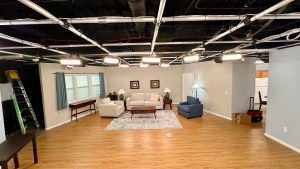 FX Design Group‘s collaboration with Ikan on the Relias training facility exemplifies PoE’s transformative potential beautifully. Tasked with creating four distinct sets within an existing structure, FX Design faced seemingly insurmountable infrastructure challenges. Traditional lighting would have required extensive electrical work, permits, and months of frustrating delays.
FX Design Group‘s collaboration with Ikan on the Relias training facility exemplifies PoE’s transformative potential beautifully. Tasked with creating four distinct sets within an existing structure, FX Design faced seemingly insurmountable infrastructure challenges. Traditional lighting would have required extensive electrical work, permits, and months of frustrating delays.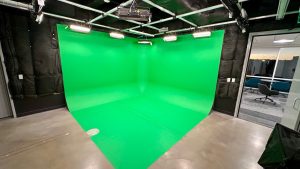
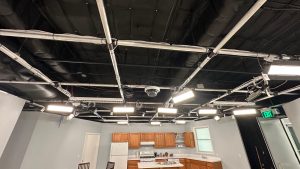
PoE lighting enabled completion within the client’s aggressive timeline while exceeding expectations. Installation proceeded without permits, without electrical contractors, and without disrupting ongoing operations. The facility now operates four broadcast-quality sets, each independently controlled through intuitive network interfaces, consuming a fraction of the power traditional lighting would require—a testament to intelligent innovation.
Buyer’s Checklist and ROI Calculator Inputs
Evaluating PoE adoption requires systematic assessment of facility characteristics and operational requirements to maximize benefits. Ceiling height determines optimal fixture selection—spaces below 12 feet strongly favor PoE’s efficient low-profile designs. Existing network infrastructure quality impacts implementation costs; buildings with modern Cat6 deployments gain immediate advantages from this smart approach.
Power availability paradoxically favors PoE in constrained environments. Facilities lacking available electrical capacity face expensive service upgrades for traditional lighting. PoE operates confidently within existing power budgets, drawing from the same infrastructure supporting computers and phones—eliminating costly electrical upgrades.
Control workflow requirements shape system architecture decisions. Organizations committed to automation platforms like Q-SYS maximize PoE’s impressive integration advantages. Those maintaining traditional lighting boards may find the transition more complex but ultimately rewarding.
Future expansion plans warrant careful consideration. PoE’s modular nature simplifies incremental growth beautifully—adding fixtures requires only available switch ports and cable runs. Traditional systems often demand complete electrical system redesigns for expansion, creating costly barriers to growth.
ROI calculations must encompass total lifecycle costs to reveal true value. Include permit fees, installation labor, energy consumption, maintenance requirements, and opportunity costs from delayed deployments. Organizations typically achieve payback within 18-24 months through operational savings alone, accelerating to 12 months when factoring avoided infrastructure costs—demonstrating compelling financial benefits.
Key Takeaways
- PoE lighting eliminates 6-12 month permitting delays that plague traditional studio builds, empowering faster deployment
- Single-cable infrastructure reduces installation costs by $10,000-20,000 per studio while simplifying complexity
- Energy consumption drops 75-95% compared to traditional tungsten or HMI sources, delivering substantial operational savings
- Network-based control enables powerful automation impossible with conventional DMX systems
- Low-voltage classification satisfies strict safety requirements in educational and corporate environments confidently
- Professional quality (97 CRI) matches traditional broadcast fixtures while dramatically simplifying operation
- Modular architecture supports flexible incremental expansion without costly infrastructure redesign
The convergence of broadcast quality and IT simplicity has arrived, empowering organizations with unprecedented possibilities. Studios no longer face the false choice between professional capabilities and practical implementation. PoE lighting delivers both brilliantly, transforming how modern studios approach the fundamental challenge of illumination while enabling creative professionals to focus on what they do best—creating exceptional content.
